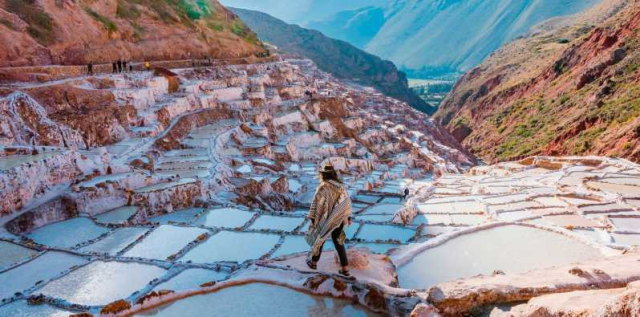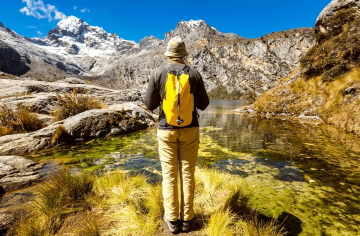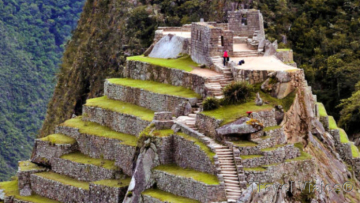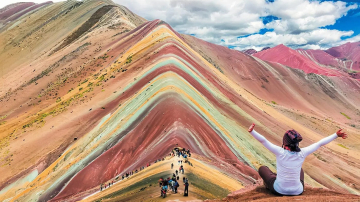In the heart of the Sacred Valley of the Incas , the Maras Salt Mines are a living testimony to man's ingenious adaptation to his environment. This impressive landscape of brine terraces has been used since pre-Incan times , standing out not only for its unique beauty , but also for the cultural and economic wealth it represents for the region.
Over the centuries , these mines have maintained their traditional extraction methods , becoming an example of sustainability and cultural heritage. In this blog, we will explore their history, the harvesting process, and the experiences you can have when visiting this fascinating destination.
1. History of the Maras Salt Mines
The Maras Salt Mines, located about 40 kilometers from Cusco , are one of the oldest legacies of the Sacred Valley. According to historians, these mines began to be exploited long before the expansion of the Inca Empire , when local communities discovered the properties of the saline waters that emerge from a nearby spring.
During the Inca period , this resource was integrated into the economic and cultural system of the Tawantinsuyu . Salt was not only used to season food , but also as a currency and for food preservation. After the arrival of the Spanish, the mines continued to be an important source of trade , and ancestral extraction techniques have been preserved to this day.
2. A Unique and Picturesque Landscape
The landscape of the Maras Salt Mines is one of the most striking in the region . Formed by more than 3,000 salt pools of different sizes , these terraces reflect shades that vary between bright white and ochre , depending on the time of year and the concentration of minerals.
From the nearby viewpoints , visitors can appreciate the geometric and natural beauty of the place , with the Andean mountains as a backdrop . This environment is not only ideal for photography , but also for connecting with the history and nature of the Andes.
3. The Traditional Extraction Process
The method of salt extraction in Maras is still practically the same as that used by the ancient inhabitants . The saline water comes from an underground spring and is distributed through a system of canals to the pools. Once the water evaporates due to the action of the sun, a layer of salt remains which is collected manually.
This process takes weeks and requires patience and skill. Local families are responsible for maintaining and working the pools , following a communal system that has been passed down through generations. This salt, known as the "pink salt of Maras" , is prized for its purity and high mineral content.
4. Experiences and Activities for Visitors
A visit to the Maras Salt Mines not only offers a visual spectacle , but also an opportunity to learn about and participate in local traditions. Visitors can walk the trails surrounding the pools , listen to local guides explain the extraction process , and in some cases, participate in the harvesting.
In addition, in nearby shops and markets , you can buy Maras salt in different forms, from coarse crystals for cooking to aromatic salts for baths. These purchases directly support the families who work in the mines , promoting responsible tourism.
5. How to get to the Maras Salt Mines
The Maras Salt Mines are located in the Maras district , about a 50-minute drive from the city of Cusco . You can get there by booking a tour from the city, which often includes a combined visit with Moray and other attractions in the Sacred Valley , or travel independently by taxi or public transport to the town of Maras and walk to the mines.
The road to the mines offers spectacular views of the Sacred Valley, with landscapes ranging from agricultural fields to the snow-capped peaks of the Andes . Once there, visitors must pay a small entrance fee, the cost of which helps preserve this unique heritage.
6. Tips for your Visit
- Best Time: Although the Maras Salt Mines can be visited year-round, the dry months of April through October offer clear skies and better conditions for photography.
- Clothing and Footwear: Wear comfortable clothing, sunscreen, and footwear suitable for walking on dirt trails.
- Respect for the Site: Mines are a workplace for local communities . Avoid touching the salt or entering the pools without permission.
- Guided Tours: Consider hiring a local guide for a detailed explanation of the history and operation of the mines.
Conclusion
The Maras Salt Mines are much more than a tourist destination; they are a symbol of the connection between Andean communities and their natural environment. This unique landscape, shaped by centuries of tradition , is a perfect example of how culture and nature can coexist in harmony.
Visiting Maras will not only allow you to enjoy stunning views and learn about an ancient process , but also contribute to the sustainable development of local communities. It is certainly a place you should include in your itinerary through the Sacred Valley.
We invite you to learn more about Peru here: Blogs from Peru.




